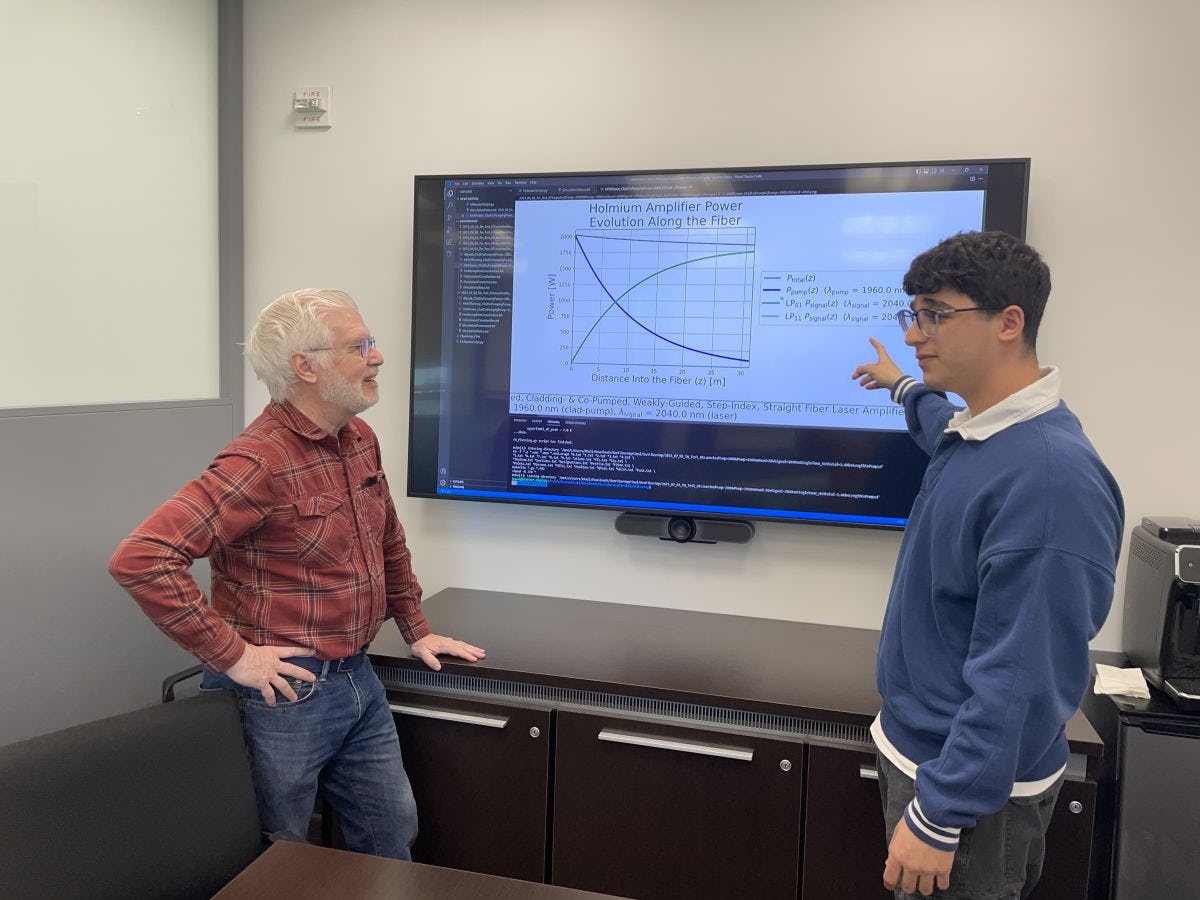Stevens student’s senior design project focuses on amplifying the power of fiber-optic cable transmissions
Think about making a call on your cell phone. How does it reach the person you’re calling? We’ve come a long way from two tin cans and a piece of string! Most of today’s telephone calls send radio waves into the 5G broadband cellular network, where they travel as light waves along delicate glass fibers encased in cables. It’s powerful, but it’s still limited, particularly as the light diminishes across very large distances.
Khalid Musa ’23, an optical engineering major at Stevens Institute of Technology, is working to give those light beams a boost by enhancing the amplifiers that are installed every so often along the fibers. These fiber amplifier devices use rare-earth atoms that act like little laser beams to absorb one color of light and then pump it out at another color that needs amplification.
“Just as speakers amplify sound, a fiber laser amplifier increases power throughout the length of the fiber optic cable,” explained Musa, whose work in this area is part of his capstone senior design project. “A rare-earth metal such as erbium, ytterbium, thulium or holmium is incorporated, or doped, into a section of the fiber. Then another light source is pumped into the fiber through another glass layer, called the cladding. This pump light excites the doped area and creates dopant ions, which increase power throughout the length of the fibers.”
This project was inspired by Musa’s 2022 summer internship with the Air Force Research Lab in New Mexico, where he and his mentor worked on enhancing high-power fiber laser amplifiers. Through his senior design project, Musa is using an Air Force Research Lab computer program, encompassing thousands of lines of code, to analyze the viability of individual and multiple rare-earth dopants in fiber laser amplifiers. He is exploring absorption and emission spectra, efficiency, energy transfer mechanisms and other properties of these elements to adjust the code and simulate the atoms’ performance in the fiber laser amplifiers.
“You can set a lot of configurations, from which atoms you’re using, how many atoms you’re using, and what combination of atoms you’re using, to how much power you want to pump into the fiber, the length of the fiber, the cladding radius, the wavelength size and color and more,” he said. “The goal is to modify this code to include a co-doped option, which means it incorporates two different dopant types simultaneously.”
Navigating conventional tools to advance new technology
It’s not an easy task, and the obstacles kicked in from day one.
“Even getting the code to start did not come easy,” Musa said. “It’s based on a Linux operating system, using Python and also Fortran, which is native to Linux, but I need to run it on the Windows operating system. Then I got the holmium to run and started working on the co-doping.”
Another challenge has been finding and translating data such as atomic properties from existing hard-copy graphs that aren’t available on databases or other electronic resources. He’s still investigating as-yet elusive data on interactions between the dopants. It’s tedious work, but when they’re plugged into the codes that Musa can now run in as little as three minutes, it’s worth the investment.
“Those little challenges are the things that usually chew up a lot of your time when you're doing research,” noted Ed Whittaker, physics professor at Stevens, and Musa’s senior design advisor. “The devil’s in the details. Solving these intricate problems of making code work and interpreting and using data from old journals may seem not as interesting as finding the latest supernova, but they’re still essential for progress. It’s how you learn to overcome challenges that matters.”
One way Musa found solutions was to find and reach out to subject matter experts.
“It’s an important lesson when you're starting out,” Whittaker added. “You have to be willing to ask anyone for help, and when you do that, you often find you can do things that are greater than if you toiled on things all on your own.”
In addition to keeping the telephone lines humming with conversations, Musa’s research has the potential to support the design and development of high-performance fiber lasers for applications including telecommunications, industrial processing, medical devices and national defense.
“I love a good challenge,” said Musa, who is looking forward to continuing the work this summer when he returns to the Air Force Research Lab for another internship. Then, in the fall, he’ll return to Stevens for graduate work in quantum computing.
Whittaker appreciates Musa’s fiber optic research, and also how this work has bolstered Musa’s opportunities and Stevens’ reputation.
“What he's doing with the Air Force Research Lab will serve him well as he progresses in his career,” Whittaker said. “He's met people who are showing him how to do things that he never would have learned about otherwise. That's opening doors for him and helping him see the larger world. He's also an ambassador for us. The lab may also be more actively interested in taking another Stevens intern now that it has seen what our students can do. Connecting with other organizations and people sustains us and strengthens the fabric of our institution.”


